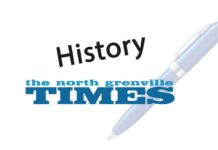For the first decades of the Nineteenth century, the four townships of Wolford, Oxford, Montague and Marlborough were administered as a unit, with a single council meeting in Merrickville, which, though small in size, was yet the central urban hub of the four townships. The Minutes of Council from 1802 until 1846 were set down in a “Town Book…for the Use of the Township of Woolford [as the Clerk spelt it constantly] and the Townships Incorporated therewith, Viz., Montague, Marlborough & Oxford”. It seems the Minutes were kept on separate sheets of paper, until the book itself was “Purchased by Mr. Joseph Haskins” in 1809 for the princely sum of 20 shillings, or £1; quite a lot of money in those days.
In January of 1818, the leading members of the Townships submitted a report to Robert Gourlay as part of the survey he was conducting of the Townships of Upper Canada. It had been prepared by individuals of both political and military influence, and the names, though spelled differently from what we’re used to, represent some familiar families. The Burritt family of Burrit’s Rapids were represented by Stephen Burret, Henry Burret, Calvin Burret, and Edmund Burret, while Daniel Burret is named as the Lieutenant-Colonel of the 2d. Regiment, Grenville Militia.
Two families who gave their names to settlements were William and Stephen Merick, and William N. and Harley Easton. J. H. Davis was the Town Clerk, while William Davis was the Captain of the 2d. Regiment Grenville Militia. Other familiar names were Asahel Hurd, Richard Olmsted, and Edward and Thomas McCrae. The use of military titles was natural, given that the local militia regiment had been an important element of the community during the War of 1812, and it also reflected the Loyalist roots of the area. Officers in the regiment held a place of influence and status in the pioneer community.
In 1818, the Imperial Government in London was determined to populate the lands between the Ottawa and the St. Lawrence with loyal settlers, and those with a military background were especially valuable, as it was fully expected that another war with the United States was practically inevitable. The overall British strategy was to build a canal along the Rideau route, and populate the surrounding territory with settlers from Scotland and Ireland, intersperse with veterans, for the future safeguarding of the Rideau region.
Although the original aim of setting up a major military depot in the Kemptville or Burritt’s Rapids area failed to materialise, nevertheless, the population of the surrounding area grew steadily after 1818. Oxford-on-Rideau grew from just 71 in 1818, to 268 just four years later. Wolford had not increased the number of inhabitants very much at all. Twelve discharged soldiers had been settled there in 1815 under the Imperial plans, but most of them had left by 1822. Only three immigrant families had been settled in Wolford under the scheme.
The Gourlay survey, taken in January, 1818, showed that “in the year 1817, the population contained upwards of 300 of both sexes, and the number of inhabited houses is 55.” There was just one doctor in the community, and the only religious service available was “performed once a fortnight in one of the school houses, by a professor of the episcopalian Methodist church”.
Education, however, was clearly very important to the people, as there were four schools, three of which the provincial government paid $100 per year to support, while the fourth was paid for by the parents of the children who attended it. This cost them 15 shillings per student per quarter. It might be assumed that this last school was of a higher standard than the others, given the cost to the students.
Along with four schools, there were four taverns and stores to cater to the needs of Wolford and district. But the lack of inhabitants was pointed out in the survey as one of the biggest obstacles to growth in the four Townships. To change that, infrastructure improvements were needed, particularly in the area of transportation. The survey report noted that, although the roads were fairly decent, more was needed.
The roads were “In tolerable repair, and passable in summer and winter for any kind of carriage. In spring and autumn they are rather bad; but are capable of great improvement at a moderate expence. [sic] The water conveyance could be made passable for boats of any burthen, without the assistance of locks, &c. The government of this province have it in contemplation to erect a canal along the river Rideau, and continue it to Kingston, which, if it succeeds, will be a great acquisition to this part of the country.”
In the meantime, the social and economic life of the Townships carried on in its usual way, as will be seen next time.






